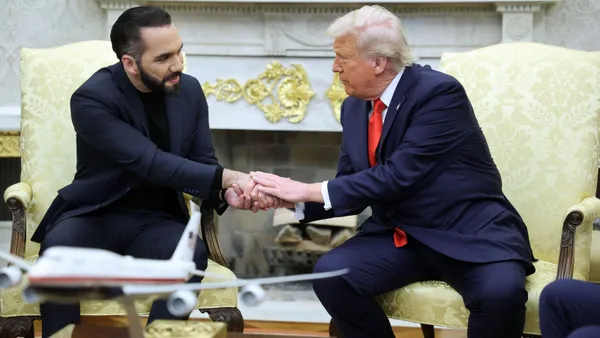Dive Brief:
- Increasing the federal minimum wage to $15 an hour by Jan. 1, 2025 could raise the wages of some 27 million U.S. workers, but could also leave a median estimate of 1.3 million workers out of a job who otherwise would be employed, according to a study by the Congressional Budget Office (CBO) released Monday.
- The CBO's study specifically examined a plan for a minimum wage increase that would be implemented in six annual increments starting Jan. 1, 2020, and that would be tied to median hourly wages after reaching $15 an hour in 2025. Researchers also concluded that aside from the median estimate of 1.3 million workers, there would be a "two-thirds chance" under such a plan that the change in employment would be between zero and a net reduction of 3.7 million workers. Wage gains under a $15 federal hourly minimum would be somewhat offset by higher joblessness rates; such an increase would also reduce business income and raise prices on consumers, the CBO said. For families living below the federal poverty line, such a plan would give them 5.3% increase in real income, moving an estimated 1.3 million people above the poverty line.
- Researchers noted two reasons why the outcomes of the study are uncertain, the first being that wage growth under current laws is uncertain, CBO said, and could either minimize or exacerbate the impact of minimum wage increases. The second: there is "considerable uncertainty" over how responsive employment is to such increases.
Dive Insight:
Advocates on both sides of the issue have taken the outcomes of the CBO study to argue for or against increasing the federal minimum wage, but as the agency itself stated, there are some uncertainties surrounding both the study itself as well as the impact of minimum wage increases on employment for observers to consider.
Other research on the minimum wage has yielded mixed results. A study released in June by researchers at the University of California, Berkley found that raising minimum wages would not decrease employment or hours workers in the areas studied, and that increases would instead reduce poverty rates among households and children. A 2018 study showed generally that jobs that pay below a new, higher minimum wage are eliminated, while those that pay above that higher rate are not.
The progressive think tank Economic Policy Institute (EPI) addressed the CBO's findings on job losses due to minimum wage increases, with EPI senior economist and director of policy Heidi Sheirholz writing that policymakers "must be skeptical" in their assessment of the study, because the CBO "failed to appropriately weight the highest quality studies in the vast academic literature on this issue."
Some employers, dealing with external pressure from the market as well as employee advocates, have chosen to raise their own minimum wage. Amazon did so in October 2018, amid criticism from U.S. Senator Bernie Sanders. Others have since done the same, including Target and Bank of America.
Recent attempts to increase the federal minimum wage have stagnated in Congress, but several states either currently have or will soon put into effect minimum wage rates higher than that mandated by the federal government. In May, Connecticut lawmakers approved an incremental increase to the state's minimum rate to $15 an hour by 2023, with an initial increase to $11 an hour starting in Oct. 2019.
Economists also note that wages have not budged significantly for most U.S. workers despite the current period of economic expansion. A January economic letter published by the Federal Reserve Bank of San Francisco stated that researchers did not foresee sharp wage growth should the U.S. labor market continue to tighten. But the bank did say that differences exist in the assessment of local and national labor markets, and that labor mobility may play less of a restricting role on wage growth in some areas.














